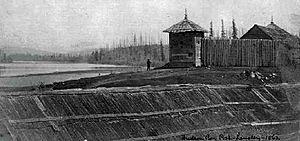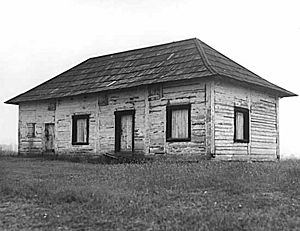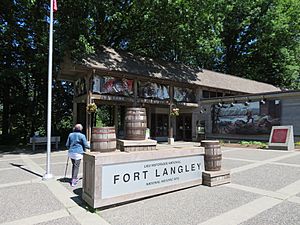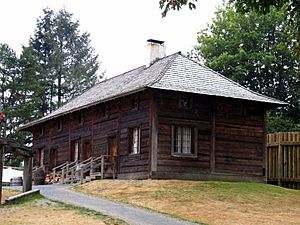Fort Langley National Historic Site facts for kids
Quick facts for kids Fort Langley National Historic Site |
|
|---|---|
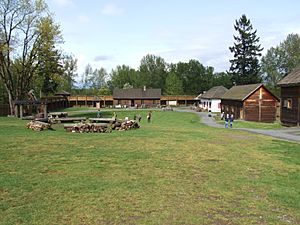
Inside Fort Langley National Historic Site
|
|
| Location | 23433 Mavis Ave Langley, British Columbia, Canada |
| Founder | James McMillan Donald Manson |
| Built | 1827 (original) 1839/1840 (second site) |
| Built for | Hudson's Bay Company |
| Original use | Trading post |
| Rebuilt | 1957–58 |
| Current use | Reconstructed living museum |
| Visitors | >74,000 (in 2023) |
| Governing body | Parks Canada |
| Designated | 23 May 1923 |
| Lua error in Module:Location_map at line 420: attempt to index field 'wikibase' (a nil value). | |
Fort Langley National Historic Site, often called Fort Langley, is a historic fur trading post. It was once owned by the Hudson's Bay Company. You can find it in the community of Fort Langley in Langley, British Columbia, Canada.
The historic site sits by the Bedford Channel, across from McMillan Island. Today, it has a visitor centre and a mostly rebuilt trading post. This post includes ten buildings surrounded by tall wooden fences called palisades.
Fort Langley was first built in 1827 in an area now known as Derby. The fort's operations moved to its current spot in Langley, with a new fort finished in 1839. However, a fire destroyed much of this new fort in 1840, so it had to be rebuilt again. The Hudson's Bay Company used the fort until 1886, when it stopped being a trading post.
By the 1920s, only one building from the original fort remained: the storehouse. In 1923, the site was named a National Historic Site of Canada. The storehouse became a museum in 1931, teaching people about the North American fur trade in the 1800s. Parks Canada rebuilt the fort's other buildings and palisades in the second half of the 1900s.
Contents
Fort Langley: A Historic Trading Post
Before the Fort: The Sto:lo People
Before Fort Langley was built, the Fraser Valley area was home to the Sto:lo people for thousands of years. The Sto:lo used the Fraser River for resources like fish. It also helped them travel and connect with other Indigenous communities. The Fraser Valley was a very rich area for resources before Europeans arrived.
The Sto:lo people had complex societies, art, and buildings. The Royal Proclamation of 1763 said that First Nations owned their land in British North America. This meant the land belonged to the Sto:lo nation. Without treaties between the British government and the Sto:lo, settlers or companies were not supposed to take the land.
Why Fort Langley Was Built
After the War of 1812, the North West Company took over a fur trading post called Fort Astoria. It was renamed Fort George and became a main trading spot. Furs from northern areas traveled south along the Fraser River. Then they went overland to the Columbia River and finally to Fort George.
The Oregon Country was shared by the British and Americans. But this agreement was ending in 1828. Since Fort George was on the American side of the Columbia River, it would likely become part of the United States.
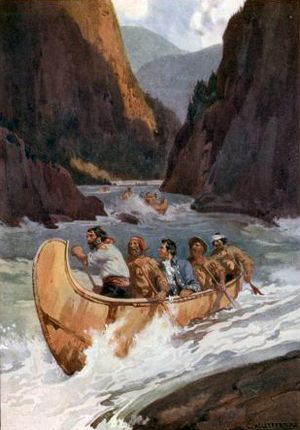
In 1821, the North West Company joined with the Hudson's Bay Company (HBC). George Simpson, an HBC leader, suggested building Fort Vancouver on the north side of the Columbia. But he also wanted a bigger trading hub further north, near the mouth of the Fraser River. Simpson believed this new location would help protect the coast from American traders. He also thought the Fraser River was easier to travel than the Columbia.
He sent Chief Trader James McMillan to explore the area. McMillan found a good spot near the Salmon River. It was good for farming, and there were lots of fish.
History of Fort Langley
The First Fort: 1827
In 1827, James McMillan returned to the Fraser River with 24 men. They included Iroquois people, Native Hawaiian workers, and a Métis worker. They began building Fort Langley, named after Thomas Langley, an important HBC director. It was about 50 kilometers (31 miles) from the mouth of the Fraser River.
This first fort was not in the same spot as today's fort. It was 4 kilometers (2.5 miles) northwest, in an area later called Derby. When the men arrived in late July, some were sick, and the horses were tired. Despite these problems, the remaining 19 men started clearing the land for the fort.
The men at the fort relied heavily on the Sto:lo people. They needed the Sto:lo's skills and knowledge to survive. To build strong relationships, the fort's men were encouraged to marry Sto:lo women. This shows how much the settlers depended on the Sto:lo, who were the original inhabitants of the land.
They planted potatoes in a garden. By mid-August, the first bastion (a strong tower for defense) was built. A second one was finished by the end of the month. The palisade walls were completed in early September. The HBC men were worried about the Indigenous people of the Fraser. The bastions were built first "to command respect in the eyes of the Indians." Once the fort was enclosed, only Indigenous people with furs were allowed inside the gate. Many buildings were constructed through the autumn, and Fort Langley was officially finished on November 26. Native laborers lived in a camp close to the fort.
Early Trade and Challenges
In the first few years, the fur trade with the Stó:lō people was not as good as the HBC hoped. Traders from Boston controlled most of the Maritime Fur Trade along the coast. This competition kept fur prices very high, much higher than what Hudson's Bay was paying elsewhere. McMillan was told to sell furs for less than the Americans. This was to force them out and give HBC a monopoly. This meant Indigenous people had to trade five beaver skins for one two-and-a-half point HBC blanket.
Also, Indigenous people along the river were not very interested in hunting or trapping furs. They mainly lived on salmon. The Stó:lō started trading salmon with the HBC, which later became an important export for the Fort. Since they had little contact with Europeans, they were self-sufficient and didn't really need European goods. In the first year, guns were in high demand to fight attacks from the Laich-kwil-tach. But when this threat ended, firearms became less common trade items. 1829 and 1831 were the best years for fur trading, with 2,500 skins each year. The fort's staff also started pickling salmon, making almost 300 barrels in 1831.
Another disappointment for the HBC was that the Fraser River was not as easy to travel as George Simpson had thought. Simpson and others traveled down the Fraser towards Fort Langley. They found that travel was easy until it met the Thompson River. After that, strong rapids and steep cliffs made the journey very dangerous. At least part of the journey from the north had to be done overland to avoid the Fraser Canyon and Hell's Gate.
The Second Fort: 1839
The HBC wanted to get rid of American competition. So, in 1839, they tried to control the fur market in Alaska by making a deal with the Russian American Company.
The location of Fort Langley was moved four kilometers (2.5 miles) upstream in 1839. The fort's focus changed from fur trading to farming, fishing, and cranberry harvesting. Although the fort was finished in 1839, a fire destroyed much of it in 1840. This meant it had to be rebuilt again.
Trading was now only allowed through a small window, with guards on the second floor. In 1840, the farm had plenty of potatoes. It also produced 750 bushels of wheat, 500 bushels of oats, and 600 bushels of peas. Catholic Missionary Modeste Demers visited Fort Langley. He held religious services for the staff and nearby Indigenous people, baptizing over 700 children in 1841.
Gold Rush and New Colony
Fort Langley grew a lot because of its important location. It was on the northern edge of the Oregon Territory and in the path of the Fraser Canyon Gold Rush. It played a key role in setting the 49th parallel as the border with the U.S. It was also the starting point for gold seekers heading up the Fraser Canyon.
The gold rush changed things for many Indigenous peoples of the Fraser Valley. They lost their trading relationship with the HBC. Settlers also started moving onto their land. This made it harder for Indigenous people to access their traditional fishing spots and land. It also disrupted their traditional ways of life. New laws made it difficult for the Stó:lo to trade their fish to earn a living.
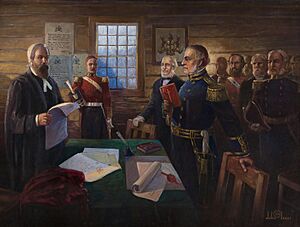
The large number of new people led the British Parliament to create a new colony on the Pacific Mainland. Some thought Fort Langley might become the capital. But Colonel Moody, a military commander, thought it was too hard to defend. He ordered the building of New Westminster further down the Fraser River, because it was easier to protect.
On November 19, 1858, the official announcement that created the Colony of British Columbia was read out at Fort Langley. James Douglas was named the colony's first governor. Douglas made this announcement while traveling upriver to deal with American miners. This was a move to prevent the area from being taken over by the U.S. after the Fraser Canyon War.
The fort slowly declined over the next 30 years. First, paddle wheelers on the Fraser River meant boats could travel further upstream to Fort Hope and Fort Yale. Second, the capital of the colony was set up in New Westminster, and later moved to Victoria. Finally, other businesses started competing, ending the Hudson's Bay Company's monopoly. In 1886, Fort Langley stopped being an HBC post.
Becoming a National Historic Site
In 1923, the Canadian government named Fort Langley a National Historic Site. They put up a plaque near the storehouse. At this time, only the storehouse and about 0.4 hectares (1 acre) of land remained. From 1931 to 1956, a group called the Native Sons and Daughters of British Columbia ran a museum in the storehouse.
Parks Canada took control of the site in 1955. A joint program rebuilt three buildings in time for British Columbia's 100th birthday in 1958. In 1978, the site became a national historic park. Since 1985, it has covered 8.5 hectares (21 acres).
In 2019, students from Langley Fine Arts School worked with members of the Kwantlen Nation. This project, called This is Kwantlen, aimed to show more Indigenous representation at Fort Langley. Photos and stories of Kwantlen First Nation members were displayed outside the Fort Langley National Historic Site and around Fort Langley in April and May 2019.
Exploring the Fort Grounds
The national historic site is located where the second Fort Langley was built in 1839. It sits above the banks of the Bedford Channel, across from McMillan Island. The historic site covers about 8.4 hectares (21 acres).
When the federal government first bought the property in 1924, it was only about 0.4 hectares (1 acre). But it grew over the years. It expanded in the 1950s when several buildings were rebuilt for British Columbia's centennial. It expanded again in the 1990s.
Inside the fort's palisades, there are ten buildings. Only one, the storehouse, is from the 1800s. The other nine buildings are reconstructions, meaning they were rebuilt in the 1900s to look like the originals. However, the site still has archaeological remains and clues from the 19th-century fort. Most buildings are used to teach visitors about the fort's history. Two buildings are used for maintenance and storing artifacts.
Outside the fort's palisades, there is also a visitor centre, built in 1997.
Bastion and Palisades
The fort is surrounded by strong timber palisades. Archaeologists found where the original palisades stood after the fort became a national historic site in 1923.
A two-story bastion, made of logs with a pyramid-shaped roof, stands along the northeast palisade walls. This northeast bastion has small, unevenly shaped square windows and two doors on its second level. These doors allow access to the walls. The northeast bastion was rebuilt in 1957.
Buildings Inside the Fort
The fort's storehouse is a rectangular building with one and a half stories and a sloped roof. It is the only building left from the original fur trading fort. It was rebuilt in the 1840s after a fire destroyed a similar building in 1839. It was also the only building that survived after the fort stopped being an active trading post. The Mavis family, who later bought the land, used it as a barn for many years. Then, Fort Langley was recognized as an important historic site in 1923.
Many other buildings at the fort are reconstructions. The Big House is a rebuilt two-story log structure from 1958. It is the largest building inside the fort's walls. The outside of the log building is painted white. The Big House is a reconstruction of the homes where James Murray Yale and his wife, and William Henry Newton and his wife, Emmaline (Tod) Newton, lived.
The servants' quarters is a one-and-a-half-story rectangular timber building with a white exterior and a sloped roof. It was also rebuilt in 1958. The servants' quarters shows what living conditions were like for three different HBC employees. This building used to show how barrels were made until 1992, when that display moved to the new cooperage. Both the Big House and the servants' quarters were built using a special method called Red River frame construction.
The blacksmith shop was first built in 1973 and then rebuilt in 1975. It has a working forge and offers live demonstrations of blacksmithing. The cooperage was built in 1992, a little south of its original spot. It has all the tools needed for making barrels and other woodworking. The Depot was rebuilt in 1997 and is mainly used for exhibitions and offices. The original building was a supply depot for goods coming in and out of the Fort.
See also


